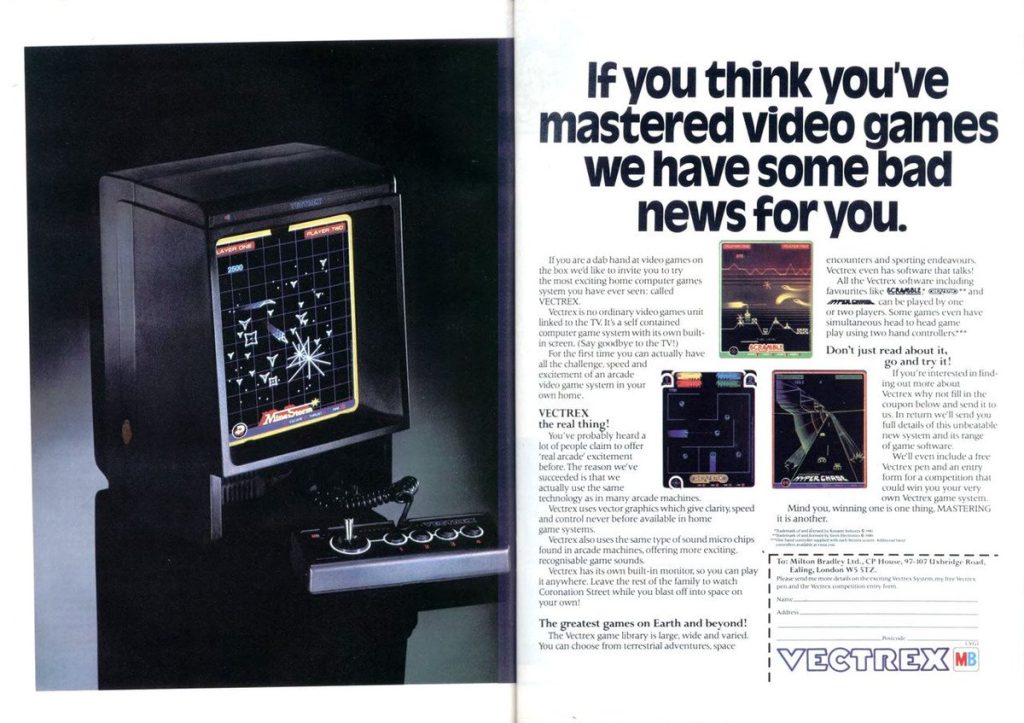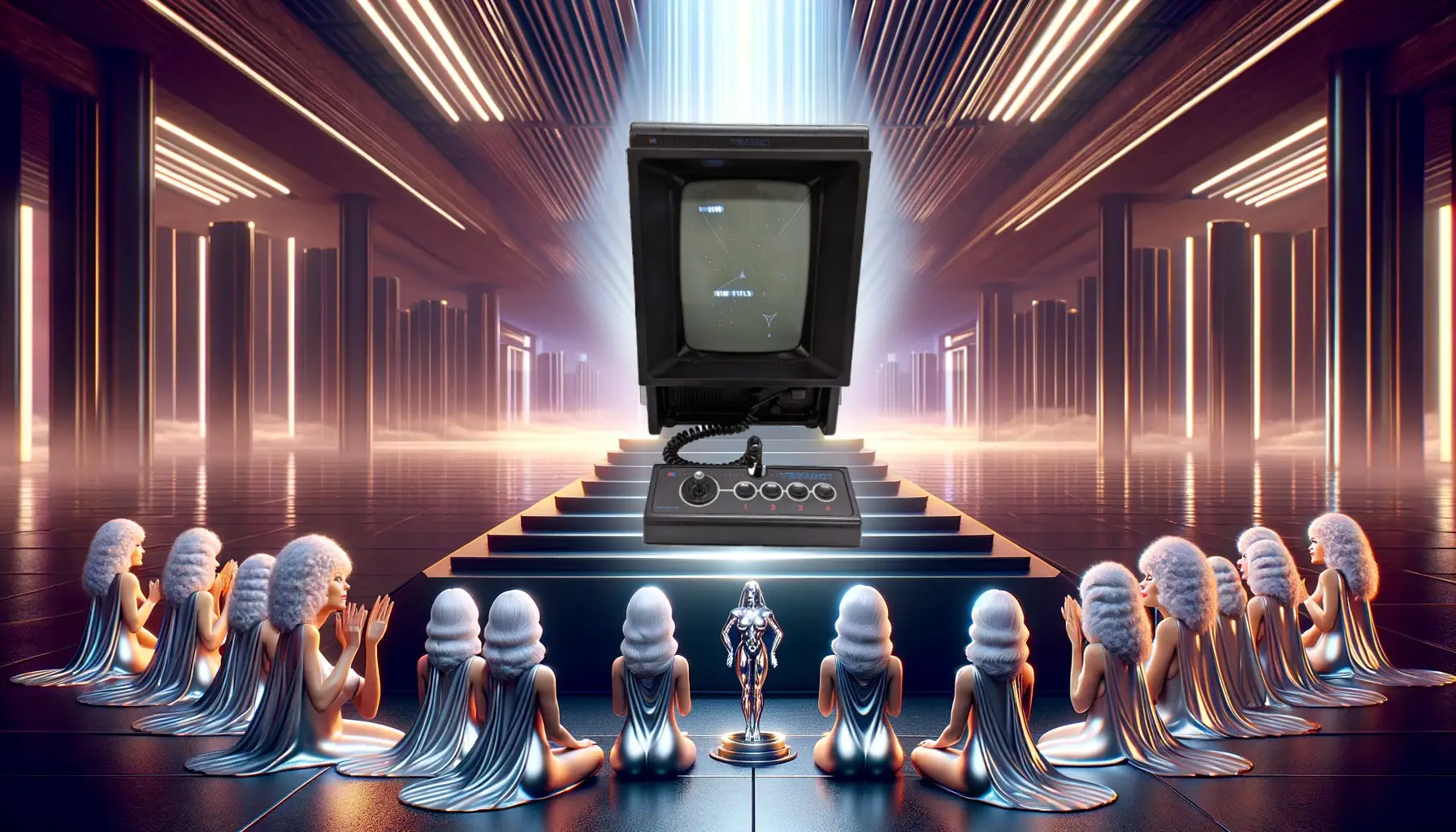Introduction to Vectrex
The Vectrex, launched in the early 1980s, stood as a pioneering home arcade system, distinct for its integrated vector display, a novelty in the video game console market. Designed to deliver a high-quality gaming experience directly out of the box, it included a monochrome screen that rendered graphics in crisp, clear lines rather than the pixels used by its contemporaries.
This technology enabled the Vectrex to offer more dynamic and fluid visuals, aiming to replicate the arcade experience in a home environment. The console was also unique in its all-in-one design, incorporating both the screen and controls into a single unit, setting it apart from other systems that required connection to a television.
Despite its innovative features and potential to redefine home gaming, the Vectrex faced significant challenges in a rapidly evolving market, leading to its eventual discontinuation.
However, its launch marked a significant moment in gaming history, showcasing the potential for innovation and the evolving expectations of gamers in the early 1980s.
Design and Technology
The Vectrex console was a marvel of design and technology, particularly noted for its unique approach to video game graphics through the use of a built-in vector display. Unlike the raster displays prevalent in the early ’80s, the Vectrex’s vector graphics system produced images composed of lines drawn directly to the screen, allowing for sharper and more fluid animations. This was a stark contrast to the blocky, pixelated images that characterized most video games of the era. Powered by a Motorola 68A09 processor, the Vectrex boasted a 1.5 MHz CPU and was equipped with 1 KB of RAM, sufficient for the complex calculations required to generate its distinctive vector graphics.
The Vectrex’s sound capabilities were driven by the General Instrument AY-3-8912 sound chip, providing three channels of sound that complemented its visual output. This combination of advanced audio and visual technology made the Vectrex stand out, offering an immersive gaming experience that was revolutionary at the time.
Furthermore, the Vectrex was designed with portability in mind. Its all-in-one design, incorporating the display and controls into a single unit, made it a versatile system that could be easily transported and set up anywhere, a significant departure from the typical console setups that required an external television.
The engineering behind the Vectrex also addressed the limitations of its monochrome display by including color screen overlays that players could place on the screen. These overlays added a splash of color to the games, enhancing the visual experience without altering the fundamental vector graphics technology.
Despite its eventual discontinuation, the Vectrex remains a testament to innovative design and technology in the gaming industry, demonstrating an early attempt to push the boundaries of what video game consoles could offer. Its legacy continues to influence modern gaming, reminding us of a time when simplicity and ingenuity went hand in hand to create something truly remarkable.
Game Library and Accessories
The Vectrex’s game library and accessories were integral to its unique gaming experience, showcasing the console’s innovative capabilities. Despite its relatively short lifespan, the Vectrex boasted a diverse array of games, ranging from arcade classics like “Mine Storm” and “Scramble” to original titles that took full advantage of the system’s vector graphics. Each game was designed to highlight the console’s ability to produce sharp, dynamic visuals, setting them apart from the pixelated games of the era. The Vectrex also offered a variety of genres, including shooters, puzzle games, and sports simulations, providing gamers with a broad entertainment spectrum.
In addition to its distinctive game library, the Vectrex was complemented by innovative accessories that further enhanced its appeal. One such accessory was the 3D Imager, a groundbreaking device that transformed the Vectrex’s two-dimensional vector graphics into a stereoscopic three-dimensional experience. By wearing the 3D Imager, players could see certain games in 3D, adding a new level of immersion to the Vectrex experience. Another notable accessory was the Light Pen, which allowed users to interact directly with the screen, enabling them to draw or select options in compatible games and software. This early form of touch interaction predated similar technologies in later gaming systems and personal computers.
The inclusion of screen overlays with each game cartridge was another unique aspect of the Vectrex’s design. These overlays, which players placed directly on the Vectrex screen, added color and thematic backgrounds to the games, compensating for the console’s monochrome display. Each overlay was custom-designed for its corresponding game, enhancing the visual experience by adding depth and context to the on-screen action.
The Vectrex’s game library and accessories underscored the system’s innovative approach to gaming, offering players a unique blend of visual flair and interactive possibilities. Despite the console’s eventual decline, these features left a lasting impression on the gaming community, cementing the Vectrex’s legacy as a pioneer in the industry.
Market Performance and Challenges
The Vectrex’s journey in the market was a tale of innovation facing formidable challenges. Launched in an era when the video game industry was crowded and highly competitive, the Vectrex initially captivated audiences with its unique vector display technology and self-contained design. Its early market performance was promising, as it offered a novel gaming experience that set it apart from the prevailing raster graphics-based consoles. However, the Vectrex soon encountered several hurdles that hindered its long-term success.
One significant challenge was the high cost associated with its advanced technology. The Vectrex’s price point was a barrier for many consumers, especially when compared to more affordable alternatives. This issue was exacerbated by the economic conditions of the early 1980s, which made discretionary spending on video game consoles less feasible for the average household.
Moreover, the video game crash of 1983 delivered a devastating blow to the entire industry, including the Vectrex. The market was saturated with consoles and games, leading to a loss of consumer confidence and a significant decline in sales. Milton Bradley, which had acquired the Vectrex, attempted to revitalize its market presence through aggressive price cuts. Despite these efforts, the Vectrex struggled to regain its footing, ultimately leading to its discontinuation.
The Vectrex’s challenges were not solely external. Internally, the console faced limitations in its game library and development support. While its games were innovative, the Vectrex did not attract enough third-party developers to sustain a diverse and expanding game library, a factor crucial for the longevity of any console.
Despite these challenges, the Vectrex remains a beloved piece of gaming history, celebrated for its ambitious attempt to redefine home gaming. Its market performance, though hindered by various factors, underscores the difficulties of pioneering new technologies in a rapidly evolving and unpredictable industry.

The Discontinuation of Vectrex
The Vectrex’s discontinuation in the mid-1980s marked the end of its commercial journey, but it also began a new chapter as a cult classic within the retro gaming community. Despite its relatively brief presence in the market, the Vectrex has cultivated a dedicated following, attracted by its unique characteristics and pioneering spirit. This enduring legacy is a testament to the console’s innovative design and the nostalgic charm of its vector-based games.
The Vectrex’s appeal lies not just in its technological novelty but also in the quality of its game library and the uniqueness of its all-in-one design. Unlike other consoles of its time, the Vectrex offered a self-contained gaming experience, with its built-in monitor and distinctive vector graphics. This made it a standout piece of hardware that has fascinated gamers and collectors alike for decades.
Moreover, the Vectrex is celebrated for its ahead-of-its-time features, such as the 3D Imager and Light Pen, accessories that showcased the console’s potential for immersive and interactive gaming experiences. These innovations have earned the Vectrex a special place in the history of video gaming, highlighting what could have been possible if it had continued to evolve.
The Vectrex’s cult following is also fueled by a vibrant community of enthusiasts who preserve and expand its legacy. Homebrew developers create new games for the console, demonstrating its lasting appeal and versatility. Online forums and fan sites serve as hubs for sharing knowledge, trading games and accessories, and celebrating the Vectrex’s unique place in gaming history.
Collectors and retro gaming aficionados treasure the Vectrex for its historical significance, rarity, and the distinct gaming experience it provides. It stands as a symbol of a bold experiment in video gaming, a reminder of a time when innovation sought to push the boundaries of what was possible in home entertainment. The Vectrex’s legacy endures, not only as a relic of the past but as an inspiration for future generations of gamers and developers.
Legacy and Cult Following
The Vectrex system, despite its commercial challenges and eventual discontinuation, has left an indelible mark on the landscape of video gaming, cultivating a legacy that extends far beyond its original market presence. This enduring legacy is most vividly reflected in the dedicated cult following the console has garnered over the decades. Enthusiasts and collectors alike cherish the Vectrex for its unique approach to gaming, its pioneering vector graphics technology, and its distinctive library of games, many of which cannot be found on any other platform.
The Vectrex’s appeal is multifaceted. It is not just the nostalgia for the early days of video gaming that draws people to this console, but also the appreciation for its engineering and the innovative vision it represented at the time. The Vectrex was ahead of its era, offering portable, high-quality vector graphics at a time when such a concept was revolutionary. This has made it a subject of fascination for those interested in the history and evolution of gaming technology.
Moreover, the Vectrex has inspired a vibrant homebrew community that continues to develop new games and software for the console. This not only keeps the Vectrex alive in the hearts and minds of its fans but also introduces it to new generations of gamers. The creation of new content, alongside forums and social media groups dedicated to the Vectrex, facilitates a sense of community and shared passion among its aficionados.
Collectors also play a significant role in the Vectrex’s legacy, seeking out not just the console and its games, but also rare accessories like the 3D Imager and Light Pen. The pursuit of these items often leads to international connections, as collectors trade, sell, and share their finds with others in the Vectrex community.
In essence, the Vectrex’s legacy is a tapestry of innovation, nostalgia, and community. It stands as a testament to the impact that visionary design and technology can have, resonating with enthusiasts and collectors worldwide and securing its place in the annals of gaming history.
Conclusion
In retrospect, the Vectrex’s story is a fascinating narrative of innovation, challenge, and enduring legacy within the video game industry. Despite its commercial struggles and eventual discontinuation, the Vectrex remains a beloved icon among retro gaming enthusiasts. Its unique vector graphics, pioneering accessories, and the cult following it has amassed over the years underscore its significance as a trailblazer in gaming technology. The Vectrex’s journey from a bold experiment to a cherished classic illustrates the lasting impact of creativity and ambition in the ever-evolving landscape of video games, serving as a poignant reminder of the industry’s dynamic history and the timeless appeal of pioneering design.
